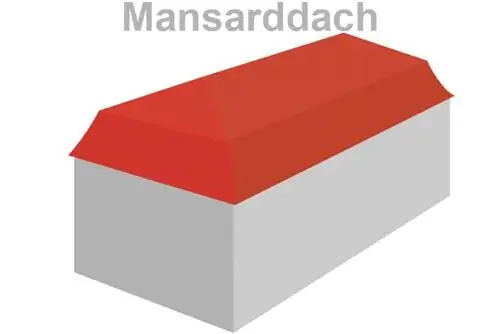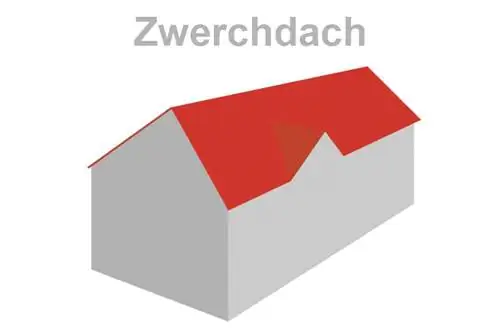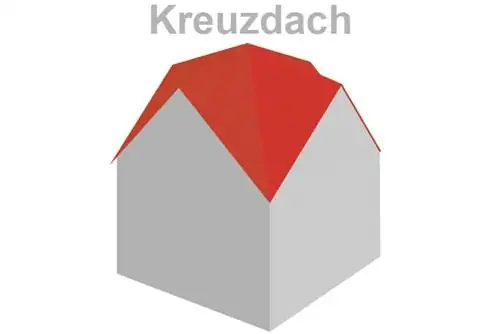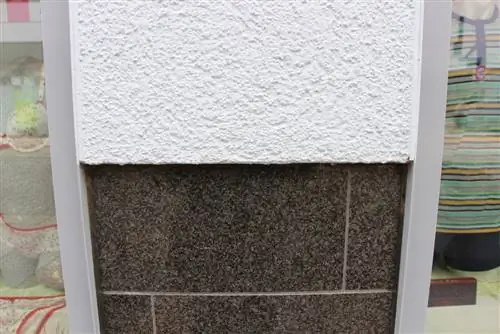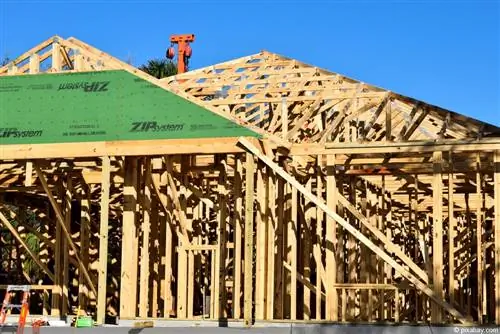- Author admin [email protected].
- Public 2023-12-17 03:39.
- Last modified 2025-01-24 12:45.
Art Nouveau and the turn of the century are probably what many people think of when they see a mansard roof. The establishment of the roof shape goes back even further in history. However, its well thought-out construction has not lost any of its relevance to this day. We explain the advantages and disadvantages and provide helpful information about the construction.
Form and creation
The mansard roof was created in the 16th and 17th centuries, where it was used to give representative town houses and palaces a balanced ratio between wall surface and roof. Like the Belle Etage, it joined the almost mandatory canon of upper-middle-class architectural language in the 19th century. Ultimately, a mansard roof is a gable roof that overlaps the top “normal” floor with a roof surface that becomes steeper at the bottom. Looking at it the other way around, you could say that a mansard roof is created when you bend the roof surfaces outwards in order to accommodate another floor with full-fledged rooms with straight walls in the attic space.
Function
Today, in addition to its design effect, the mansard roof has another function that should not be neglected. Numerous development plans use the number of floors and the height of the eaves to regulate the extent of structural use of an area. By accommodating the top floor in the roof, in contrast to the classic gable roof, a much more usable floor can be gained than would ever be the case with a gable roof. The classic stylistic device of the mansard roof acquires a new meaning in order to make the most of the building planning regulations.
The construction
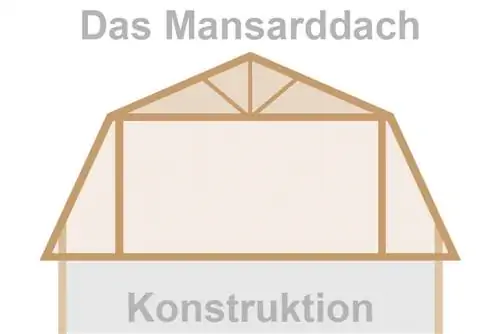
Constructively, the mansard roof is always a purlin roof. Because the roof surface bends upwards, the rafters cannot run from the eaves to the ridge and therefore cannot support themselves against each other. As a rule, the mansard floor is integrated into the roof structure as a wooden frame. The central purlin rests on these walls, which also serves as a threshold for the flatter upper roof. Depending on the use, the framework can be made into full-fledged walls, so that you are only aware of being in the attic space when looking out the windows. By setting up a floor-to-ceiling knee height, even the steep roof slope is not noticeable from the inside. At the same time, the steep roof pitch allows the installation of normal facade windows and thus unrestricted good lighting and ventilation of the rooms.
The static challenge
Particular attention is paid to the statics when constructing the mansard roof. The underlying, classic gable roof transfers the loads acting on the roof surface via continuous rafters to the outer walls of the building and from there via the foundation components into the ground. In conjunction with the outer walls or an additional layer of stiffening beams, this results in a stable static system in the shape of a triangle. With a mansard roof, however, the continuous rafter is interrupted and taken out of a straight line by the outward bending of the roof surface. In particular, the loads of the upper roof area develop a clear downward pressure when the loads are transferred, as well as additional outward pressure in the bend area. It is important to absorb this outward pressure constructively and prevent the roof from giving way. For this purpose, a layer of beams is usually installed above the mansard floor, or several metal tie straps are provided. Often these elements do not appear visually at all because they disappear into the walls or ceiling of the attic floor.
The roof pitch
Now there was already talk of two different roof pitches and an upper roof and a lower roof. But which inclinations are used sensibly? The obvious assumption is that in order to achieve the characteristic roof silhouette, the lower half of the roof must be steeper than the upper roof. Slopes of at least 45 degrees are common for steep roof areas, but it makes sense to have 50 degrees and more. It is not uncommon for inclinations of up to 70 degrees to be found in order to make the best possible use of the interior space behind them. The upper roof, on the other hand, can have almost any slope. In order not to create unnecessary and unusable space, an inclination of a maximum of 30 degrees is usually used, often even less. On the other hand, a mansard roof rarely gets below 15 degrees in the ridge area, as the traditionally used tile roofing only fulfills its function to a limited extent on flatter slopes.
NOTE:
Individual manufacturers now allow the roof pitch to be reduced to up to 10 degrees. However, the appearance should never be completely ignored. The greater the difference between the two inclinations, the more difficult it is to achieve a harmonious design.
Advantages and disadvantages
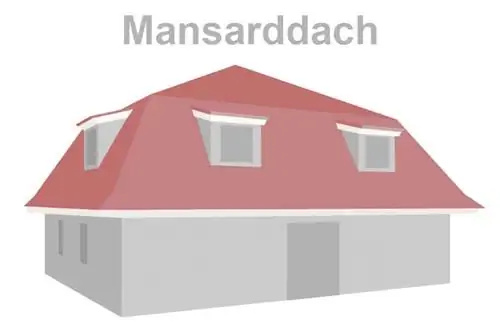
Of course, the mansard roof not only has advantages, but also some disadvantages. Both the positive and negative aspects of this roof shape are briefly highlighted below:
Advantages
- Great increase in usable space in the attic due to the steep slope in the lower roof area
- Reduction of unusable roof space in the peak of the roof due to a flatter slope in the upper roof
- Qualitative increase in the usability of the rooms in the attic through more vertical walls without large sloping ceilings and the usability of normal facade windows
- Increase in the “optical weight” of the roof, thus making a more balanced design possible from the main structure to the roof
- Construction planning advantages when limiting the height of the eaves and possibly the number of readable floors
Disadvantages
- High design effort for supporting structure
- Numerous detailed training for window connections, changing the roof pitch, etc. required
- Classic roof coverings in steep roof areas if the slope is too high is only possible with additional security
- Usability of the roof spaces is better than a “normal” gable roof, but still not a full-fledged floor
- In modern building planning law, the determination of development plans can hardly be implemented without legal exemptions
The mansard roof today
The heyday of the mansard roof may be over, but it can still be found again and again in newly built buildings today. However, not everything that looks like it is a real mansard roof. In order to take advantage of the optical and sometimes also building legal advantages of the mansard roof without having to invest in the construction effort, “normal” floors of solid construction are now often simply clad with an extremely steep roof surface. The flatter, upper roof area is then put on as a real roof construction, or is completely eliminated in favor of a flat roof. To what extent the concept of the mansard roof still applies here is ultimately up to the viewer. The fact is, however, that from a structural engineering point of view, in these cases only little of the real mansard roof of earlier times remains.

